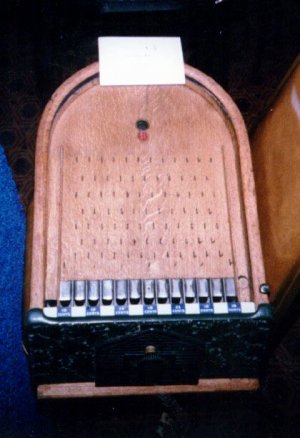The first known flipperless coin-op was made either in 1902 or 1903 by Caille Brothers, and was Log Cabin (IPD Link). Log Cabin was actually a trade stimulator used by a single player, while a store owner watched to see if the player would get a ball in one of the scoring slots. If the ball made it into one of the numbered slots, the player would win 1, 2, 3, or 10 cigars, depending on how good, or how lucky a player he was.
A Lesson About Flipperless Coin-Op
The difficult part was the pin placement on the playfield, which would deflect
the wooden ball either left or right, influencing it to enter a specific scoring
slot at the bottom of the table. Only half of the 14 slots actually would result
in a payout in cigars from the store owner. A winner had two chances each to
win 1, 2 or 3 stogies, with the big jackpot being 10 cigars. Amazingly, Log
Cabin proved extremely popular from the start, and helped spawn a new public amusement craze called Pinball.
After some two dozen years, other companies began jumping on the Flipperless bandwagon. Gottlieb was the first, in 1931. Bally, attracted by the profits to be made, came into existence in 1931. Many other companies followed suit, such businesses as Keeney, Western Equipment and Supply, and Pros-Per-I-Ti Manufacturing, as well as Peo Manufacturing. United finally started operation after WW II, although there was a United earlier, but not the well known pin maker. The number of machines that were manufactured was simply amazing, as profits poured into the pockets of every coin-op company, prompting even more companies to spring into existence. Pin players became increasingly intrigued as the advance of flipperless continued . So many flipperless were made, that most of them aren't known to anyone other than the most ardent collector, or the rare Pinball enthusiast.
People were content with these amazing skill games, and enjoyed them immensely until 1948, when the flipper was introduced.
Flipperless began to fade in popularity in the late 40s, when it seemed that
folks were no longer happy with skill machines. They enjoyed slapping the silver ball with items we know today as Flippers. Flippers were truly quite a stunning milestone that made the game every bit as challenging as flipperless pins, but with some twists. The ball would roll, pitch, and yaw around the playfield, spinning in every imaginable direction. Even with all the many advances in flippered games, pinball began fading, just as flipperless machines once had. People were less attracted to flippered machines, largely due to the splintering of the leisure market, just as flipperless had been made obsolete by flippered pinball earlier. Now with the dawning of a new century, pinball may be poised for a mild comeback, as Stern seems to be designing new machines which are exciting players senses, so that they want to play pinball once again.
The interesting thing about flipperless is that there were far more flipperless
machines manufactured than flippered. Folks seem to be wanting to play those oldies once again, given the endless variety of these flipperless machines now being found in attics, old bars and many homes of antique collectors. There were many times the number of flipperless made versus flippered machines, and considering the home-sales of high quality bagatelle into the early 60's, the imbalance could well be even more staggering. I've encountered so many unknown flipperless that aren't even in the Internet Pinball Database that it boggles the mind. No matter what machines discovered; flippered or not, there are many yet to be found, and so many that will never be known. People now seem to be drawn to these old classics for many reasons, but the very real challenge of flipperless seems to continue catching people's interest.
As a flipperless author, I do find myself enjoying the sheer thrill and skill
of nudging the ball, rather than to just slapping it around with any number
of stationary flippers. I don't find that entertaining, although many players
do. I think that when most folks discover flipperless machines, they are intrigued by what they find. The reason is simply that flipperless offer so many different designs and configurations, that every machine is completely different from any other. I've only seen probably four or five kinds of flippered machines, but whenever folks notice the variety of flipperless, some which seem to defy logic, it puts them in awe as to how those pioneering companies could figure out how to make some of these wonderful pieces of art. I've ran across some myself that seemed to make no sense, but when I play them, I marvel and wonder how they did it. Truly, the folks behind flipperless were the magicians who made pinball what it is today.
Flipperless have pulled off every conveyable trick known to man, and much more. Without the use of electricity, these machines stood the test of time and will continue to do so. Today's machines cannot compare to what those pioneers of pinball envisioned; lots of fun, skill, and some of the best darned gameplay your penny, nickel or dime could buy. We shouldn't overlook the amazing artwork each machine used, either. Today's machines just cannot compare to the oldies, and in my opinion, they never will, although I still enjoy newer pins.
druadic, commercial flipperless table author
Updated Jun 30, 2004 Written by druadic
edit by webmaster: Log Cabin has been recreated for Visual
Pinball by druadic and is Here!
A Lesson About Flipperless Coin-Op
The difficult part was the pin placement on the playfield, which would deflect
the wooden ball either left or right, influencing it to enter a specific scoring
slot at the bottom of the table. Only half of the 14 slots actually would result
in a payout in cigars from the store owner. A winner had two chances each to
win 1, 2 or 3 stogies, with the big jackpot being 10 cigars. Amazingly, Log
Cabin proved extremely popular from the start, and helped spawn a new public amusement craze called Pinball.
After some two dozen years, other companies began jumping on the Flipperless bandwagon. Gottlieb was the first, in 1931. Bally, attracted by the profits to be made, came into existence in 1931. Many other companies followed suit, such businesses as Keeney, Western Equipment and Supply, and Pros-Per-I-Ti Manufacturing, as well as Peo Manufacturing. United finally started operation after WW II, although there was a United earlier, but not the well known pin maker. The number of machines that were manufactured was simply amazing, as profits poured into the pockets of every coin-op company, prompting even more companies to spring into existence. Pin players became increasingly intrigued as the advance of flipperless continued . So many flipperless were made, that most of them aren't known to anyone other than the most ardent collector, or the rare Pinball enthusiast.
People were content with these amazing skill games, and enjoyed them immensely until 1948, when the flipper was introduced.
Flipperless began to fade in popularity in the late 40s, when it seemed that
folks were no longer happy with skill machines. They enjoyed slapping the silver ball with items we know today as Flippers. Flippers were truly quite a stunning milestone that made the game every bit as challenging as flipperless pins, but with some twists. The ball would roll, pitch, and yaw around the playfield, spinning in every imaginable direction. Even with all the many advances in flippered games, pinball began fading, just as flipperless machines once had. People were less attracted to flippered machines, largely due to the splintering of the leisure market, just as flipperless had been made obsolete by flippered pinball earlier. Now with the dawning of a new century, pinball may be poised for a mild comeback, as Stern seems to be designing new machines which are exciting players senses, so that they want to play pinball once again.
The interesting thing about flipperless is that there were far more flipperless
machines manufactured than flippered. Folks seem to be wanting to play those oldies once again, given the endless variety of these flipperless machines now being found in attics, old bars and many homes of antique collectors. There were many times the number of flipperless made versus flippered machines, and considering the home-sales of high quality bagatelle into the early 60's, the imbalance could well be even more staggering. I've encountered so many unknown flipperless that aren't even in the Internet Pinball Database that it boggles the mind. No matter what machines discovered; flippered or not, there are many yet to be found, and so many that will never be known. People now seem to be drawn to these old classics for many reasons, but the very real challenge of flipperless seems to continue catching people's interest.
As a flipperless author, I do find myself enjoying the sheer thrill and skill
of nudging the ball, rather than to just slapping it around with any number
of stationary flippers. I don't find that entertaining, although many players
do. I think that when most folks discover flipperless machines, they are intrigued by what they find. The reason is simply that flipperless offer so many different designs and configurations, that every machine is completely different from any other. I've only seen probably four or five kinds of flippered machines, but whenever folks notice the variety of flipperless, some which seem to defy logic, it puts them in awe as to how those pioneering companies could figure out how to make some of these wonderful pieces of art. I've ran across some myself that seemed to make no sense, but when I play them, I marvel and wonder how they did it. Truly, the folks behind flipperless were the magicians who made pinball what it is today.
Flipperless have pulled off every conveyable trick known to man, and much more. Without the use of electricity, these machines stood the test of time and will continue to do so. Today's machines cannot compare to what those pioneers of pinball envisioned; lots of fun, skill, and some of the best darned gameplay your penny, nickel or dime could buy. We shouldn't overlook the amazing artwork each machine used, either. Today's machines just cannot compare to the oldies, and in my opinion, they never will, although I still enjoy newer pins.
druadic, commercial flipperless table author
Updated Jun 30, 2004 Written by druadic
edit by webmaster: Log Cabin has been recreated for Visual
Pinball by druadic and is Here!



